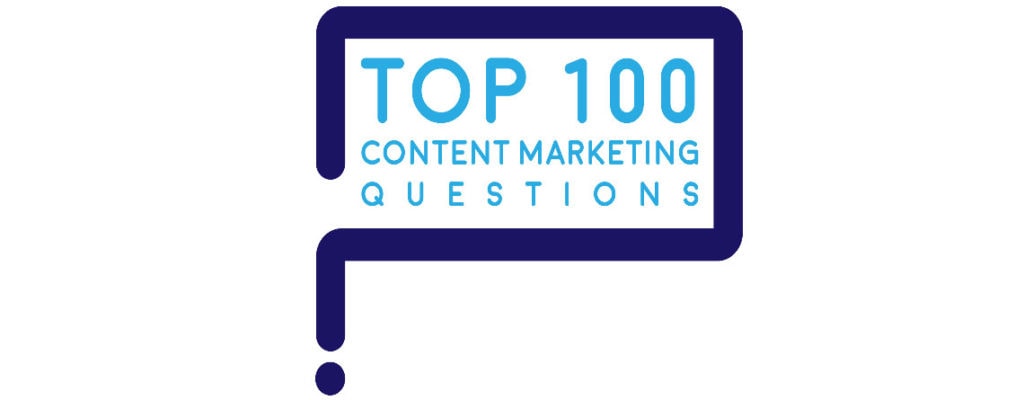
Top 100 Content Marketing Question: How to value the impact of content marketing and justify the expense/overhead?
Get the whole team aboard
To demonstrate the impact of content marketing, start by getting your executives and internal clients aboard the content marketing bandwagon. Take these steps:
Convene decision-makers in a workshop
Recruit marketing, sales, product managers, R&D, and executives to participate in a big-tent, hands-on workshop on content marketing.
To get everyone on the same page, clarify the definition of content marketing. Highlight the differences between content and content marketing.
Provide context to compare and contrast advertising and content marketing. This blog shows how advertising and content marketing are similar and how they differ.
The simple facts are:
- Over time, people are gaining increasing control of the media they watch.
- As people gain control, they tune out unwanted messages by blocking web ads, trashing direct mail, junking e-mails, and skipping ads on TV.
- To win attention, brands need content assets so valuable that people crave them. Create content that educates, informs or entertains your tribe.
- Great content wins subscribers, who give you ongoing permission to market to them.
This blog helps you make the case for the impact of content marketing.
Work with your team to co-create a content marketing mission, strategy, message and base. By doing so, you gain top-level buy-in from the start.

Create a one-sentence content marketing mission statement
Here’s a blog that shows you how to do so, including examples and an easy-to-use template.
When you create a content marketing mission statement, you maximize the impact of content marketing. A written statement helps you leapfrog ahead of the 4 out of 5 marketers who lack a written content mission.
Write a content marketing strategy on one page
Here’s a blog on how to create a one-page strategy that aligns content marketing with the needs of the business. And a free template for your one-page strategy.
A written content marketing strategy vaults you ahead of 2 out of 3 competitors.
Define your marketing message in 7 seconds, 23 words or less
Make sure it’s concise, clear and consistent.
Here’s a blog on how to create a Message Map to keep your content marketing always on message – no matter which audience or medium you’re addressing.
Brainstorm options for building your content marketing base
A content base is one type of content, on one main platform, consistently delivered over a long period of time, says the Content Marketing Institute.
Unfortunately, too many marketers skip the key step of building a content base.
Think big. Examples of successful content marketing bases include: John Deere’s magazine The Furrow, the Michelin Guide and the Red Bulletin.
![What 117 years of content marketing teaches [infographic]](https://crystalclearcomms.com/wp-content/uploads/2017/07/michelin-guide-1900-4-745x1024.jpg)
A strong content base maximizes the impact of content marketing. Think of it as a tree that dominates the landscape of your market, towering above competitors.
Ask: What content could you create that’s so valuable, customers would pay you for it? How many relationships could you start with customers by giving that valued content away free?
Need help with your content mission, strategy, message and base? Our content marketing workshops enable you to get everyone on the same page so you can become even more successful.
Choose a promising market to start up content
To maximize impact of content marketing, start in the right place: a greenfield or orphan market.
A greenfield is a new product or geographic market that has never had marketing support. An orphan market is one where marketing support fell to zero for at least one year.

Seek out a market with a short sales cycle so you can prove the benefits of content marketing more quickly.
For example, one B2B company had products that took 18 to 24 months to sell, and other products that sell in 3 to 6 months. Marketers wisely chose to start content marketing on short sales cycle products – to demonstrate results sooner.
Prepare to calculate your return on marketing investment (ROMI)
You may need to calculate a return on marketing investment (ROMI), or you may not.
Try to agree on a simple rule of thumb with your company’s chief financial officer (CFO). For example, one CFO and I worked out this formula: For each $1 in marketing expense, Marketing had to generate $3 in revenue to make a positive contribution to the business.

That made an easy-to-understand, clear measure for everyone in Marketing to follow.
If you must calculate ROMI in a more detailed way, make it easier by building a system to capture of all relevant expenses. Inputs to your content marketing system include staff time, agencies, media, freelancers and other expenses.
Make sure your inputs are compared apple-to-apples with other marketing activities.
For example, is staff time included in the costs of trade shows, advertising, brochures and other marketing deliverables? Often, it’s not.
It’s smart to include staff time in cost comparisons, especially as more and more marketers become in-house agencies.
Include staff time in content marketing ROMI only if the other marketing deliverables also include it – not if they don’t. That’s how you get to an apples-to-apples comparison.
Systematize measurement of customers, revenue, qualified leads and sales pipelines. These measurements are the outputs that executives value most.
Here’s another way to think about content marketing measurement. Too many marketers miss this angle.
Estimate the value of content as an asset
Content is not only an expense. For many brands it’s an investment that produces a long-lived asset. To determine the asset value of your content, ask:
- How many people engaged with your content in owned, earned and paid media?
- How many people downloaded your lead magnets or took a quiz or assessment?
- How many people subscribed to your blog?
- How many customer conversations did content start by helping, teaching, answering questions or entertaining people?
- How many new relationships did content launch with your brand?
- How much content did users produce for the brand? User-generated content provides a big lift for many brands: for example, Lego users produce 20 times more content than Lego marketers do.
- How much revenue did content produce? People pay for content such as the Michelin Guide, The Red Bulletin, and The Guinness Book of World Records.
Now ask: How many of these activities would have taken place, absent content marketing? What is the long-term value of content assets to the business?
To fully answer the question, “How do you value the impact of content marketing and justify the expense/overhead?” requires looking at content both as an expense and as an asset.
Why it’s easier for underdogs to value content marketing
It’s easier to see the value of content marketing in underdog companies. If your brand is an underdog, content marketing is a powerful play because it levels the field for a David-vs-Goliath match.
My former Tellabs Marketing team competed with companies 10 to 40 times our size. Since we could never outspend them, we had to outsmart them.
Content marketing became our slingshot. It put us on a level playing field where David could beat Goliath with great content.
If you compete with companies of similar size, it will take more legwork to justify the expense and impact of content marketing.
Either way, the steps above will guide you to make the best case for content marketing.

“How do you value the impact of content marketing and justify the expense/overhead?” is one of marketers’ Top 100 Questions about content marketing. Here are the answers.
Related Posts
Top 100 Content Marketing Question: How do I get better at content marketing?
To get better at content marketing, you’ll need to learn from others. To do so, look for the right boss, the right blogs, the right...
Speaking on the same topic repeatedly? Read these tips
Almost every conference, regardless of industry, requires that speaking sessions offer something new that the audience hasn’t heard before. But have you ever noticed...
Presenting at a hybrid event? Read these tips.
What is a hybrid event? The hybrid event is another way organizations have responded to life during a pandemic. Some people are now comfortable...
Top 100 Content Marketing Question: How do you connect content marketing to revenue?
To clearly connect content marketing to revenue, take 4 steps: Prove the effectiveness of content marketing by ring-fencing one specific market where the only...





